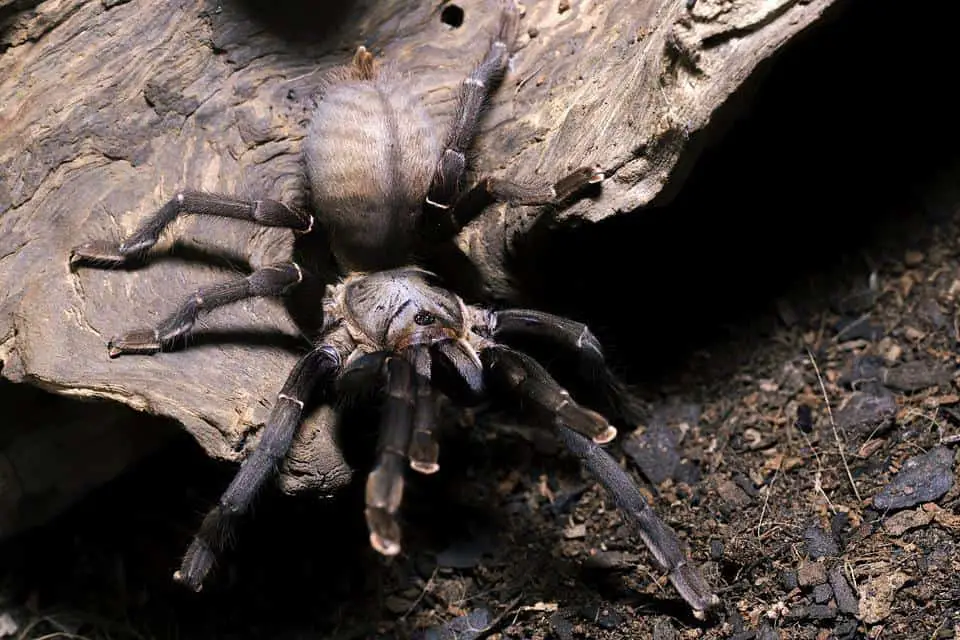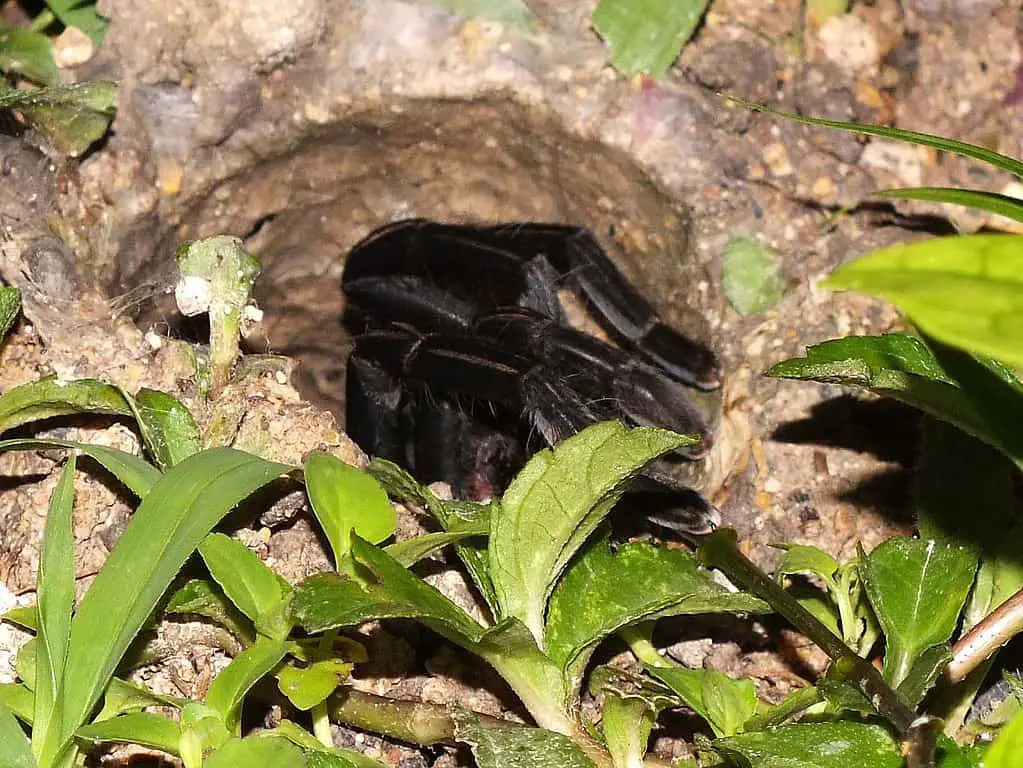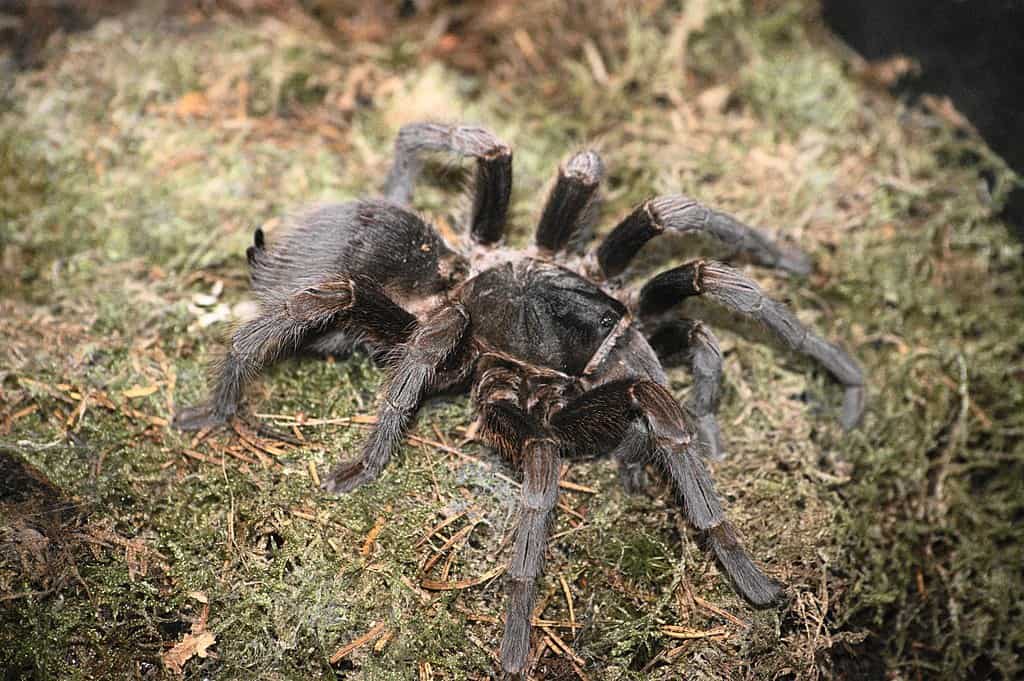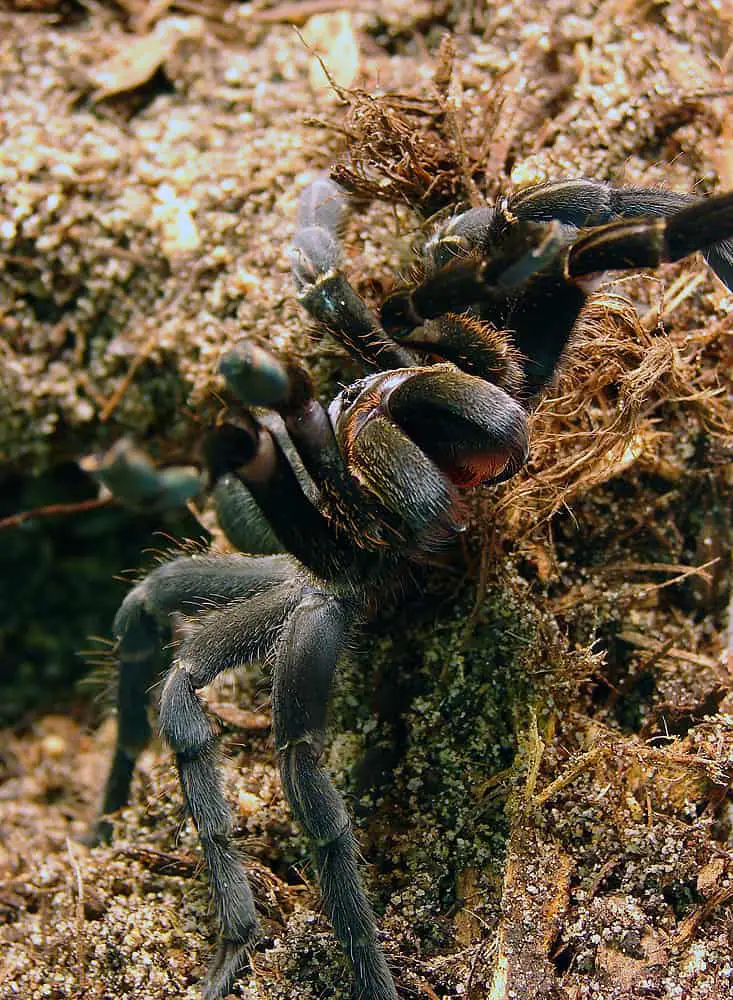The Thailand Black Tarantula (Haplopelma Minax) is an Old World terrestrial species that is native to Thailand and Myanmar. In the wild, it’s found in the forests of Southeast Asia, but its unique jet-black appearance has also made it a favorite among collectors. However, you have to know what you’re getting into because this spider is no joke and definitely not for beginners.
If you’re considering adding this magnificent animal to your collection or if you simply want to learn more about them, you’ve come to the right place. In this article, we’ll go over everything you need to know about the Thai Black Tarantula.

Thailand Black Tarantula Care Sheet
| Species Name | Haplopelma Minax |
| Family Name | Theraphosidae |
| Common Name | Thailand Black Tarantula |
| Category | Old World |
| Type | Terrestrial Burrower |
| Native Location | Thailand |
| Leg Span | 5 to 6 inches (12-15cm) |
| Growth Speed | Fast |
| Urticating Hairs | No |
| Social | Solitary |
| Diet | Insects: crickets, roaches, mealworms |
| Temperature | 75 to 85 degrees Fahrenheit |
| Humidity | 70 to 80% |
| Life Expectancy | Female: 11 to 13 years / Male: 2 to 4 years |
| Recommended Experience Level | Advanced |
| Minimum tank size | 5 to 8 gallons for adults |
Thailand Black Tarantula overview

The Thailand Black tarantula is an Old World terrestrial borrower. They spend the majority of their time in their burrows, waiting for prey to pass by so that they can ambush them. Despite having 8 eyes, they do not have very good eyesight, so they spin webs nearby their burrow. When the silk vibrates, they know that prey is nearby and they will get ready to ambush.
They have quite a potent venom, which helps them take down their prey.
Appearance

The name of this species is very descriptive. It’s jet black in color with chevron markings on its abdomen. An interesting thing about them is that they do not turn brown before molting, they will always stay a dark black color.
They also have impressive fangs that they use to take down their prey and defend themselves.
As is standard with tarantula species, the males are quite a bit smaller than the females.
Behavior & Temperament
The Thailand Black Tarantula is an extremely defensive species. They do not hesitate to strike a threat posture and are willing to attack anyone that seems like they’re a threat to them. On top of that, they’re incredibly quick and they have quite a strong venom which means that their bites are no joke.
This spider is without a doubt one of the most aggressive tarantula species in the world, which does not make them suitable for anyone but the most experienced handlers.
Since they’re nocturnal animals they will spend the majority of the day hidden away in their burrows. Because of this, they’re not very interesting to look at most of the time. They typically only really come out of their burrow to eat. They have a ferocious appetite and can grow extremely fast. Males can grow from sling to adult in a year.
Price
The price of the Thailand Black Tarantula depends on the age of the specimen (slings are cheaper than adults) and whether you buy a female or a male. Males are cheaper because they have a much shorter lifespan.
Typically, these spiders are not very expensive because their defensive nature does not make them in very high demand. Expect to pay between $20 and $85 for a specimen.
Thailand Black Tarantula Care
Habitat
Since the Thailand Black Tarantula is quite a large spider they need an enclosure large enough to accommodate them. Because they’re a terrestrial species, length is more important than height.
Shoot for a tank size that’s 4 times as big as their leg span horizontally to give them ample space. Bigger than that is not necessary because tarantulas are not very active animals. They prefer to expend as little energy as possible.
They do not necessarily need a hide since they will create their own burrow, but you can give them some cork bark, plastic plants, and other decoration to spruce up their enclosure a little.
Substrate
Due to the fact that this species needs to burrow it’s essential that they have enough substrate to do so. They need a layer of substrate of at least 6 to 8 inches to burrow properly, but more is better.
The substrate should consist of a mixture of peat moss, vermiculite, coconut fiber, and dirt.
Temperature & Humidity
When keeping tarantulas it’s always a good idea to mimic their natural temperature and humidity as closely as possible. The Thailand Black does well in temperatures between 75 and 85 degrees Fahrenheit and humidity levels between 70% and 80%.
If you’re having issues keeping the humidity at adequate levels you can moisten one side of the substrate occasionally. Alternatively, you can introduce some sphagnum moss or use an oversized water bowl to raise the humidity.
Social
the Thailand Black Tarantula is definitely not a social spider and is quite territorial. In the wild, they only meet other to mate, and even that often ends up with the male being eaten by the female. Do not try to house multiple Thailand Blacks together to avoid conflict.
Molting
Due to its fast growth rate, the Thailand Black Tarantula will molt quite frequently. Since this is a stressful time for them, make sure that you do not disturb them while they’re molting. Typically, they will refuse food and water several days before the molting process starts. Also, they cannot eat for a few days after molting because they need time for their fangs to harden.
Diet & Feeding

As previously mentioned, Thailand Black Tarantulas have a ferocious appetite. They’re big eaters and can grow quickly as a result of that.
Slings should eat fruit flies until they’re about half an inch in size. You can then introduce baby crickets into their diet. When they’re fully grown, they can start eating B. Dubia Roaches and large crickets.
Not all tarantulas need equally as much food though. The amount of food they need depends on their size and activity levels. Keep an eye on their abdomen, if it’s getting big, you’re probably feeding them too much. On the other hand, if it’s getting smaller, you might be underfeeding them.
They drink only water, so a water bowl in their enclosure is enough. Make sure that you refresh the water frequently to avoid the buildup of bacteria or mold.
Health & Lifespan
The Thailand Black Tarantula is a hardy and strong spider. In captivity, they typically live decently long lives and do not have much to fear.
The only thing that you’ll have to be a bit wary of is spider mites, parasites, and mold growth in their enclosure. If you keep an eye on these problems, keeping your spider healthy should be relatively straightforward.
Females can live for up to 13 years while males for around 2 to 4 years.
Final words: Is the Thailand Black the right Tarantula for you?
The Thailand Black tarantula is not a good species for beginners. Their aggressive nature and potent venom mean that you definitely need quite a bit of experience to care for them properly. If you’re new to the hobby, definitely get your feet wet first with a more docile species such as the Antilles Pink Toe, Mexican Red Rump, or Greenbottle Blue.
Furthermore, even if you do think you can handle them, they’re not the best show spiders. They spend a large part of their lives hidden away in their burrow, which has caused some people to refer to them as a “pet hole” because that’s all they really see – a hole in the ground with the spider hiding somewhere inside it.
- How Long Do American Eskimo Dogs Live? Important Factors and Care Tips - September 29, 2023
- Do American Bulldogs Need Grooming? Essential Tips and Care Guidelines - September 29, 2023
- Do Bengal Cats Enjoy Playing? Essential Tips for Keeping Them Active - September 29, 2023